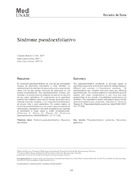| dc.contributor.author | Ramírez Uribe, Catalina | spa |
| dc.contributor.author | Parra, Juan Camilo | spa |
| dc.contributor.author | Rueda, Juan Carlos | spa |
| dc.date.accessioned | 2020-10-27T14:21:09Z | |
| dc.date.available | 2020-10-27T14:21:09Z | |
| dc.date.issued | 2007-08-15 | |
| dc.identifier.issn | 2382-4603 | |
| dc.identifier.issn | 0123-7047 | |
| dc.identifier.uri | http://hdl.handle.net/20.500.12749/10345 | |
| dc.description.abstract | El síndrome pseudoexfoliativo es una de las principales causas de glaucoma secundario a nivel mundial. La epidemiología de este tipo de glaucoma varía y se presenta como una de las causas comunes de glaucoma en los países escandinavos. Sus manifestaciones clínicas son variadas y el compromiso es bilateral, aunque en la mayoría de los casos asimétrico. El compromiso en la superficie anterior del cristalino hace que el manejo quirúrgico de la catarata sea más complejo y con mayores eventualidades en el pre, intra y post opera-torio. En nuestro medio, el síndrome seudo exfoliativo no es común, pero es importante reconocerlo, manejarlo e indicarle al paciente con claridad el pronóstico a largo plazo y evitar complicaciones. | spa |
| dc.format.mimetype | application/pdf | spa |
| dc.language.iso | spa | spa |
| dc.publisher | Universidad Autónoma de Bucaramanga UNAB | |
| dc.relation | https://revistas.unab.edu.co/index.php/medunab/article/view/112/99 | |
| dc.relation.uri | https://revistas.unab.edu.co/index.php/medunab/article/view/112 | |
| dc.rights.uri | http://creativecommons.org/licenses/by-nc-nd/2.5/co/ | |
| dc.source | MedUNAB; Vol. 10 Núm. 2 (2007): Especial Oftalmología; 117-120 | |
| dc.subject | Ciencias biomédicas | |
| dc.subject | Ciencias de la vida | |
| dc.subject | Innovaciones en salud | |
| dc.subject | Investigaciones | |
| dc.title | Síndrome pseudoexfoliativo | spa |
| dc.title.translated | Pseudoexfoliative syndrome | eng |
| dc.publisher.faculty | Facultad Ciencias de la Salud | spa |
| dc.publisher.program | Pregrado Medicina | spa |
| dc.type.driver | info:eu-repo/semantics/article | |
| dc.type.local | Artículo | spa |
| dc.type.coar | http://purl.org/coar/resource_type/c_6501 | |
| dc.subject.keywords | Health Sciences | eng |
| dc.subject.keywords | Medicine | eng |
| dc.subject.keywords | Medical Sciences | eng |
| dc.subject.keywords | Biomedical Sciences | eng |
| dc.subject.keywords | Life Sciences | eng |
| dc.subject.keywords | Innovations in health | eng |
| dc.subject.keywords | Research | eng |
| dc.subject.keywords | Pseudoexfoliative syndrome | eng |
| dc.subject.keywords | Secondary glaucoma | eng |
| dc.identifier.instname | instname:Universidad Autónoma de Bucaramanga UNAB | spa |
| dc.type.hasversion | Info:eu-repo/semantics/publishedVersion | |
| dc.type.hasversion | info:eu-repo/semantics/acceptedVersion | |
| dc.rights.accessrights | info:eu-repo/semantics/openAccess | spa |
| dc.relation.references | Konstas AGP, Hollo G, Astakhov YS, Teus MA, Akopov EL, Jenkins JN, et al. Factors associated with long-term progression or stability in exfoliation glaucoma.Arch Ophthalmol 2004; 122:29-33 | spa |
| dc.relation.references | Jacobi PC, Dietlein TS, Krieglstein GK.Comparative study of trabecular aspiration vs trabeculectomy in glaucoma triple procedure to treat pseudoexfoliation glaucoma.Arch Ophthalmol 1999; 117:1311-8 | spa |
| dc.relation.references | Oliveira C, Schlotzer-Schrehardt U, Vieira G, Liebmann J, Ritch R. Early diagnosis of exfoliation syndrome in the offspring of affected patients.Acta Ophthalmol Scand 2006; 84:512-5 | spa |
| dc.relation.references | Kivela T, Hietanen J, Uusitalo M. Autopsy of clinical unilateral exfoliation syndrome. Invest Ophthalmol 1997; 38:2008-15. | spa |
| dc.relation.references | Konstas AGP, Mantziris DA, Stewart WC. Diurnal intrao-cular pressure in untrated exfoliation and prymary open angle glaucoma. Arch Ophthalmol 1997; 115:182-5 | spa |
| dc.relation.references | Richt R, Shields MB, Krupin T. Glaucoma therapy. Exfo-liation syndrome. In: Shields B, Ritch R, Krupin T(ed). The glaucomas. St. Louis, Mosby, 2 ed, 1996:993-1023 | spa |
| dc.subject.lemb | Ciencias médicas | eng |
| dc.subject.lemb | Ciencias de la salud | spa |
| dc.subject.lemb | Medicina | spa |
| dc.identifier.repourl | repourl:https://repository.unab.edu.co | |
| dc.description.abstractenglish | Pseudoexfoliative syndrome is one of the main causes of secondary glaucoma worldwide. The epidemiology of this type of glaucoma varies and it is presented as one of the common causes of glaucoma in Scandinavian countries. Its clinical manifestations are varied and the involvement is bilateral, although in most cases asymmetric. The involvement of the anterior surface of the lens makes the surgical management of cataract more complex and with greater eventualities in the pre-, intra- and post-operative period. In our environment, pseudoexfoliative syndrome is not common, but it is important to recognize it, manage it and clearly indicate to the patient the long-term prognosis and avoid complications. | eng |
| dc.subject.proposal | Síndrome pseudoexfoliativo | spa |
| dc.subject.proposal | Glaucoma secundario | spa |
| dc.type.redcol | http://purl.org/redcol/resource_type/ART | |


